The Economic Society of Singapore SG50 Distinguished Lecture by Deputy Prime Minister and Minister for Finance Tharman Shanmugaratnam
14 Aug 20151. The story of Singapore’s first 50 years that is best known internationally is of economic progress leading to a remarkable rise in GDP per capita. But that is not the heart of the Singapore story. The unique Singapore story has been that of broad-based social upliftment: jobs for all, rising incomes for all, homes for all, quality schools and public healthcare for all, and neighbourhoods and parks shared by all.
2. It’s impossible for our economy to have succeeded without effective social strategies – most importantly, enabling people to develop their potential through education, housing policies that provided a sense of equity, or if everyone was just doing something for themselves, and we did not have a sense that we were moving up together.
3. But it’s also impossible for us to have had experienced the substantial and broad-based improvement in social well-being and life satisfaction without a vibrant economy – and large increase in real incomes, across the whole span of the workforce.
4. For both low-income and middle-income Singaporeans, real incomes have increased five to six times since 1965 (in other words, after deducting for inflation).
5. Economic and social strategies have gone hand in hand, and that’s what transformed standards of living and created the Singapore story.
6. In the first three decades, we focused on the basics. It was about economic survival. It was about providing everyone with opportunities for a good school education, for a job and to own a home. It was coupled with a strong emphasis on self-reliance.
7. The first Budget speech in December 1965, by then Finance Minister Mr Lim Kim San, was all about survival. It had a detailed assessment of the competition we faced and the constraints we had to reckon with. And one sentence to do with social subsidies: the Mount Emily Girls’ Home was to get 40 more places to allow a total of 85 girls.
8. There was very little explicit support for the poor in those early decades, and a limited array of social policies. But a whole generation was lifted out of poverty, because our economic strategies worked.
9. Jobs were created, incomes did rise, and homes went up in value steadily as the economy improved.
10. When we got to the 1990s, social policy was coming more to the fore. The Government began to take a proactive approach towards helping the lower-income group. Edusave for the young, MediFund for those who could not afford medical expenses, and housing grants for the HDB resale market.
A NEW BALANCE
11. But it was in the last 10 years, starting from around 2006 that we made a more decisive shift, a deliberate rebalancing to ensure that we remained an inclusive society.
12. We needed to mitigate inequality. We had seen a trend of rising inequality, that began from the mid-1990s. This followed a similar trend in most advanced countries. We also wanted to do more to ensure that social mobility remained alive, and to help young people to have a real chance of discovering their own strengths and do well in different fields. And we wanted to provide more assurance for older Singaporeans.
13. Starting from a decade ago, we began this series of shifts, but still part of that compact between economic and social strategies. We still had to ensure a competitive economy where incomes could rise, but we paid special attention to ensuring that the low-income and middle-income group kept up as our economy progressed.
14. All societies would like to sustain income growth, mitigate inequality, and keep their societies fluid and mobile. How have we done? Let me summarise the picture.[1]
15. We’ve managed to sustain income growth across the board. It’s been unusual among the countries in the same league as us. In the advanced countries, income stagnation has been the norm for the middle-income group. Among the Asian NIEs, Hong Kong and Taiwan have seen virtually no real income growth for the middle- and lower-income groups in the last decade.
16. Fortunately, in Singapore, we’ve managed significant income growth in the last 10 years. This chart [Chart 1] shows the significant income growth for the median household (i.e. households in the middle of the income ladder). It came about both because individuals’ wages went up and because more people took advantage of the increased job opportunities.
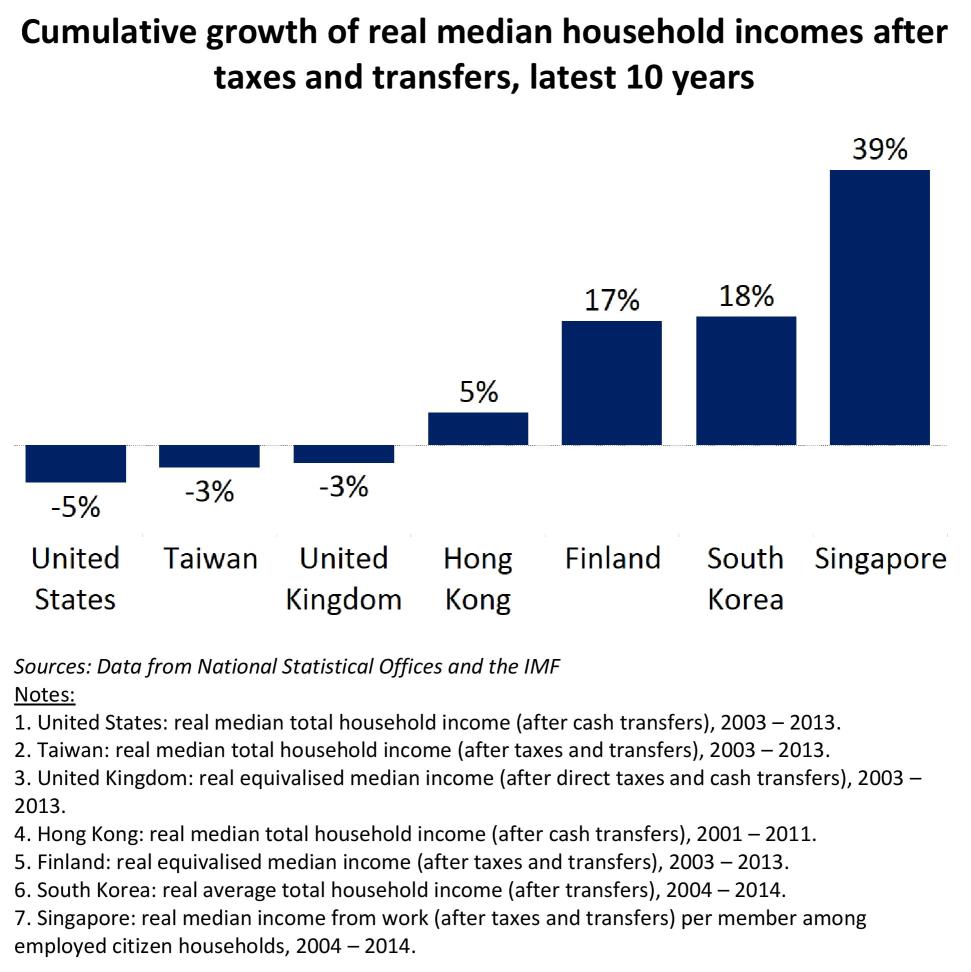
[Chart 1]
17. For the lower-income group [Chart 2], there’s a similar trend. We’ve had 37% real income growth for lower-income households over the last decade
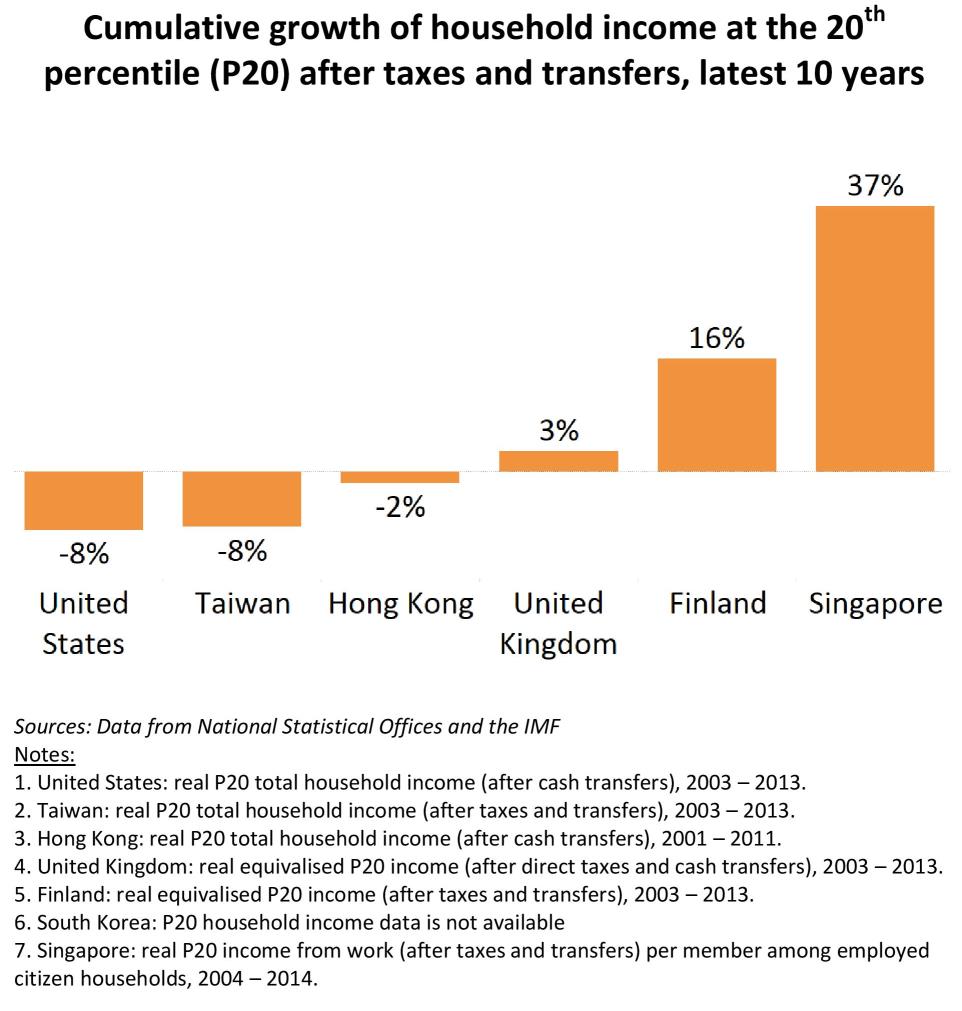
[Chart 2]
Tackling Inequality
18. What about inequality? It remains a concern. It’s useful to have some perspective of what it was like in the old days, and what the trends have been in the rest of the world.
19. Inequality was always high in Singapore – we are a city-state. As far back as we have data, we find that inequality was relatively high in Singapore. It came down a bit in the 1980s, but beginning in the mid-1990s we saw a significant increase in inequality. It followed a trend in virtually every advanced economy that had started a decade earlier.
20. In Singapore, starting from the mid-1990s we saw an increase in inequality, for a whole decade. The chart shows the trends in in Gini coefficients, using the OECD methodology for each country to ensure they can be compared. [Chart 3]
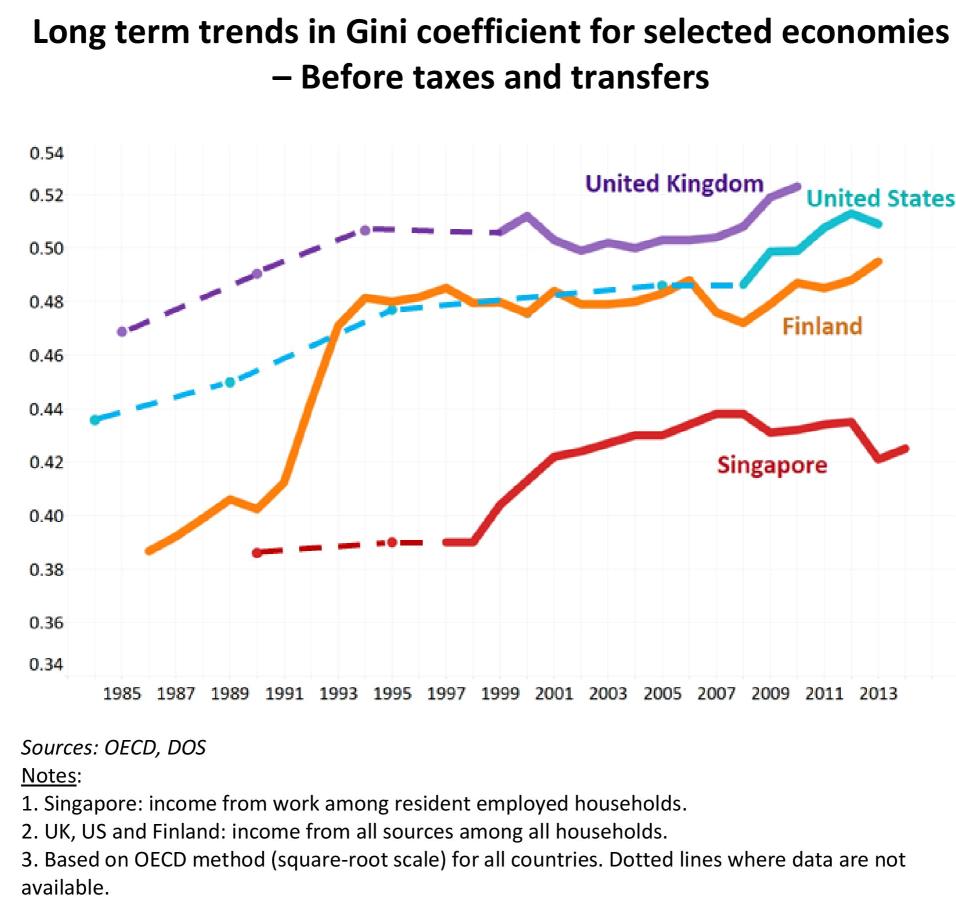
[Chart 3]
21. Our level of inequality based on incomes (before taxes and government transfers) is not particularly high by international standards.
22. The question then is what happens to inequality after taxes and transfers, because all governments engage in some redistribution, and we do too.
23. There are some countries that achieve a very large reduction in their Gini coefficients, through taxes and transfers. The classic cases are the Scandinavian economies, and to some extent several other European economies. But we must recognise that the reduction in their Gini coefficients goes hand in hand with a very heavy burden of taxation on their populations. Denmark collects about 49% of GDP in taxes, Finland about 44%. [Chart 4] In our case it’s about 16%[2]. We get some investment income from our reserves, but our tax revenues total just about 16% of GDP.
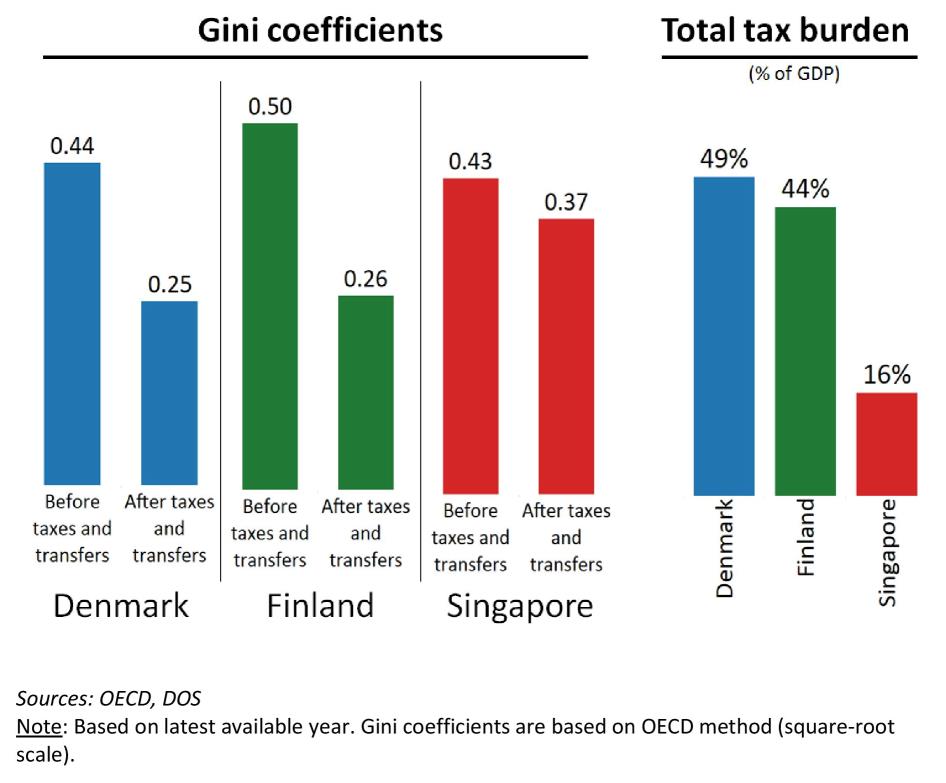
[Chart 4]
24. It's not just about taxing the rich.
25. It’s the broad middle class in these societies that pay very high consumption and income taxes, to generate the tax revenues which the state uses for redistribution.
26. [Chart 5] The average worker in Denmark pays an income tax of about 36%, consumption taxes about 25%. In Finland somewhat similar consumption tax, about 24%. Even if we look at their discounted VAT tiers – for instance in Finland it’s about 14% for food – the average worker pays a lot of taxes.
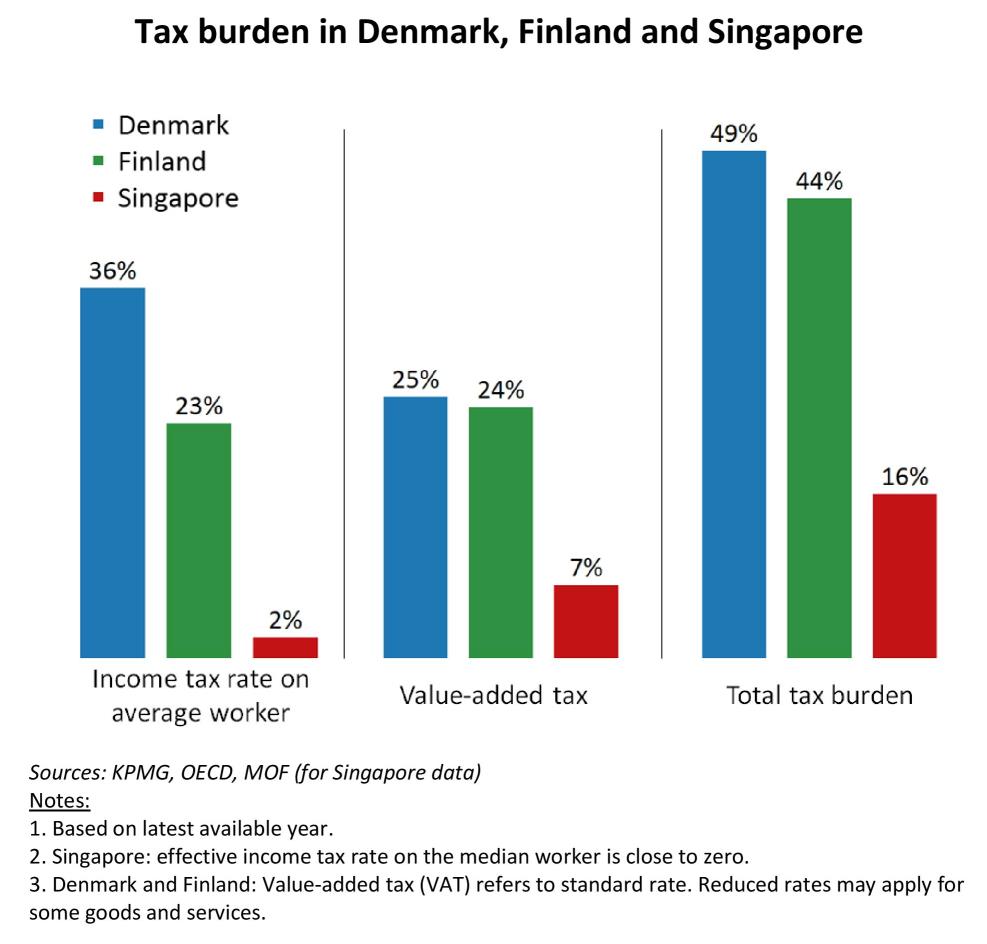
[Chart 5]
27. So that’s the basic trade-off.
28. Our approach in Singapore is to keep the overall tax burden low, certainly low by international standards. But within the tax revenues that we have, we ensure that we use it in a fair and progressive way. We target support for the low- and middle-income group, in areas which help them most.
29. We must keep the burden of taxes on the middle-income group low. It’s high for cars especially, to control congestion, but we keep income taxes for the middle incomes and keep their overall burden of taxes low. The result is a fair deal for our middle-income households. [Chart 6] With the enhancements in Budget 2015, they get $2 in government benefits for every $1 of total taxes they pay (including income tax, GST, property tax and all other taxes) – not bad. In the UK it is $1.40 of benefits, and slightly lower in Finland. The middle class in these other places does get significant benefits, but they pay high taxes.
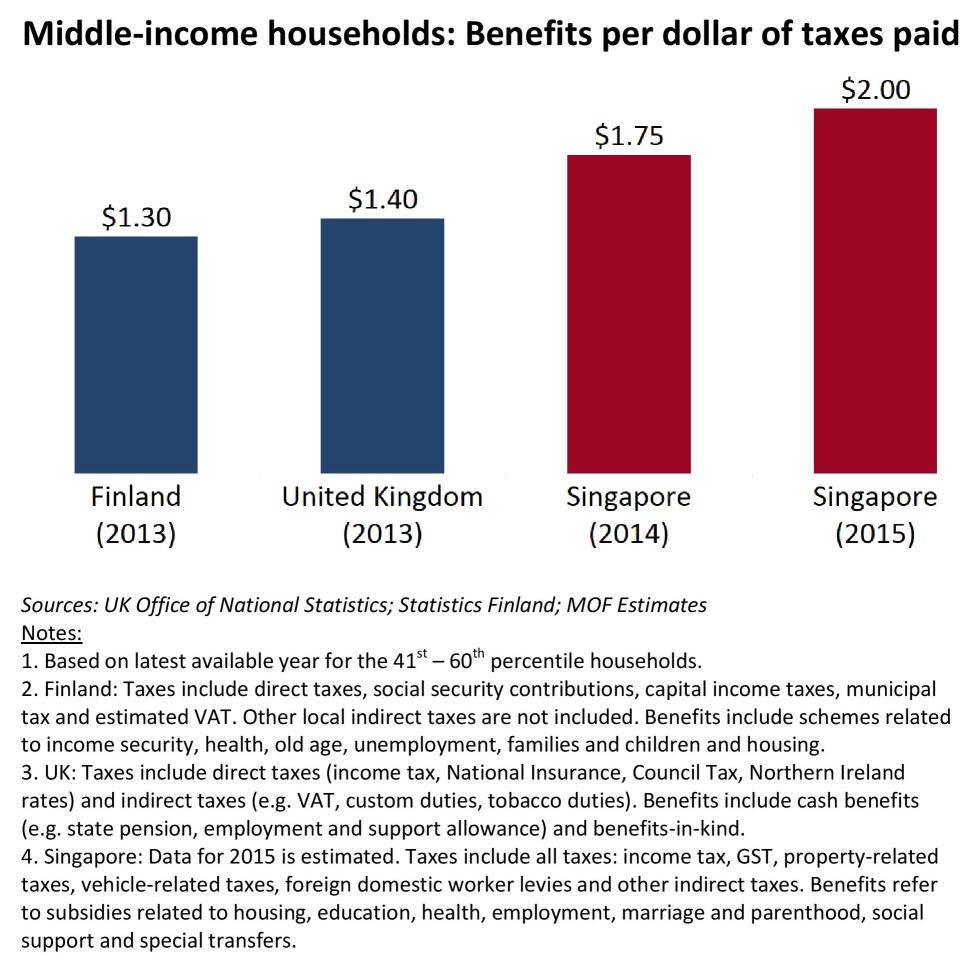
[Chart 6]
Keeping Social Mobility
30. What about social mobility? It’s the defining challenge in every advanced country today. We are fortunate that we have so far done relatively well. Chart 7 looks at where people who start-off with lower-income family backgrounds end up after they have finished education, and are well into their working lives, around their early 30s. How many of them end up in the top 20% on the income ladder? If everything was equal, if their backgrounds, abilities and how they grow up play no role in eventual incomes, every child would have a 20% chance of ending up in the top 20%.
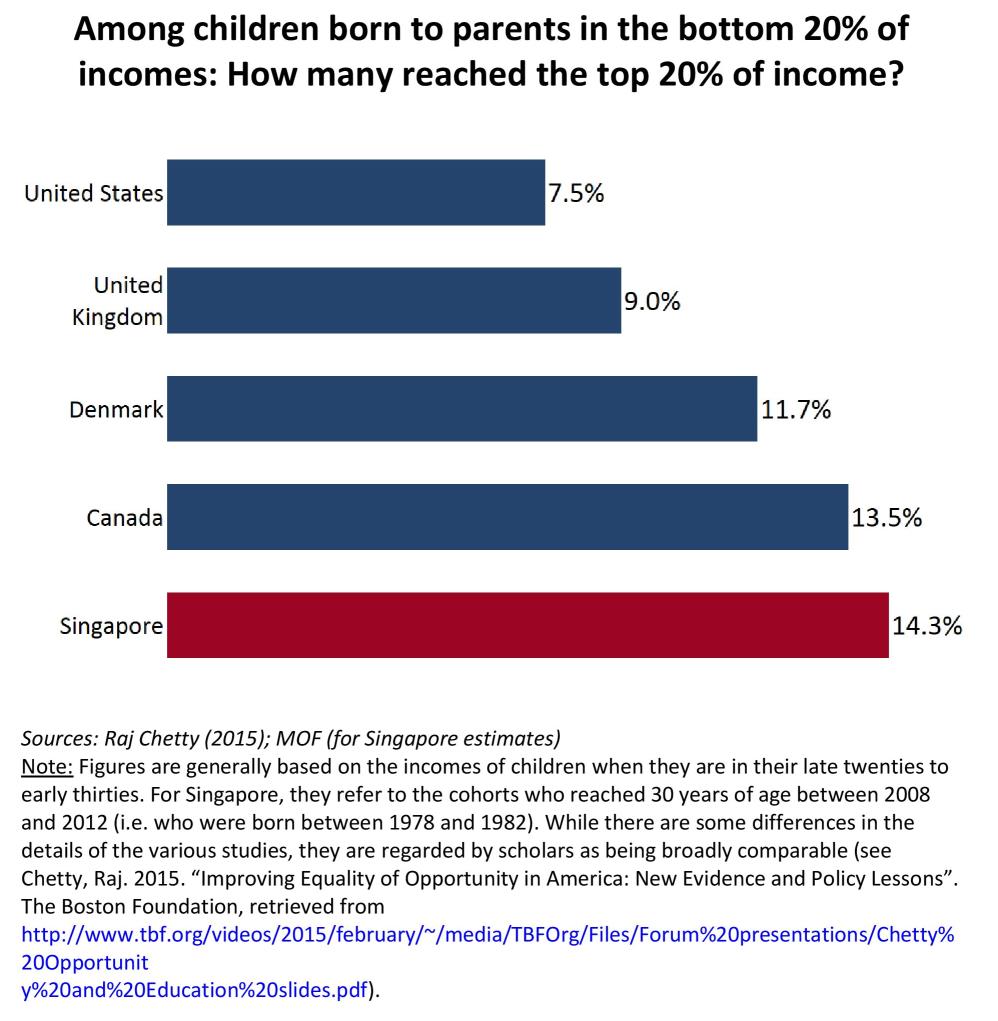
[Chart 7]
31. In the US, among those who are born to lower-income parents, only 7.5% make it to the top 20%. The UK is not very different. In Singapore, 14% of those with lower-income parents end up in the top 20% of incomes.
32. Mobility for Singapore’s lower-income children is higher than in Denmark, and almost twice as high as in the US.
33. So we have a relatively fluid society. But we know it gets more difficult with time. It means we have to work actively to keep up social mobility, find every way, starting from the early years of a child’s life, to help those with a weak start to have a real chance to move up in life.
34. Few countries have succeeded in sustaining income growth, tempering inequality, and keeping social mobility alive over a long period. For a couple of decades after the Second World War, the US and many Western European countries were in fact able to achieve all three – incomes grew for most people, there was a sense that everyone could move up, and they achieved significant reductions in inequality. It was a special time in history. Young populations, rapid growth, and in the US they had the G.I. bill giving a college education for those who fought in the war.
35. It didn’t last. Things began to stumble in the late 1970s. Incomes began to stagnate, first in the US. Social mobility faltered and inequality began a long rise.
36. I don’t say this because we think we are inherently superior to these societies. What happened to them can happen to us.
37. It’s a challenge we all face, sustaining income growth and social mobility, while mitigating inequalities. We have to work hard at it.
38. We must also keep our focus on what matters most to people: having a real chance to develop themselves and move up in life. Focus on maximising opportunities for everyone to do well, and especially for those who start with less. Focus on raising standards of living for all, even as we temper inequalities through redistributing. And we must do so with confidence in ourselves, not thinking there’s only one model to follow.
39. We must stay with strategies that are working well, learn from mistakes, keep improving and keep making a better Singapore.
A MORE INCLUSIVE AND MORE INNOVATIVE SINGAPORE
40. Two things matter greatly in our next phase of development. We have to make Singapore an innovative society. And we must continue to build an inclusive society. They go hand in hand.
41. We must be an innovative society to keep earning our place in the world, and to raise standards of living for all Singaporeans. We have to move from value-adding in global markets, to value-creation – through our own firms, with more brands of their own, as well as through multi-nationals based here, creating value in Singapore. In every field: developing new, affordable medical treatments, creating new products or apps, or finding new ways to reach customers.
42. An innovative society starts from young, of course. But we must resist the thought that we have to add something more in education to develop the innovative spirit.
43. It is more a matter of taking things out of education than putting things in. That’s a more difficult task.
44. We have to take calculated but bold steps, to evolve our system in future to provide more space for young people to explore as they grow up, and to develop the originality of mind that comes from exploring things on their own. And we must ensure too that they have enough time to interact with their fellow students, on the playing field, in dance, in adventure – every form of interaction.
45. The interactions when people are young matter not just for an inclusive society. They also matter for an innovative society. The world of innovation is not just about the brightest sparks, but about teams. In many international rankings of innovation, Switzerland tops the US. It doesn’t have Silicon Valley, but it’s a society where everyone is continuously improving, every worker is treated with respect, and the whole team becomes that much more innovative and competitive.
46. It’s also not just about the first 18 or 22 years of life, but learning through life.
47. That’s why SkillsFuture is a major social and economic investment in our future. We will invest in every Singaporean, so we all keep improving through life, keep learning something about ourselves we didn’t know, a strength, an interest. Keep expanding our potential together. We are going to provide the resources, all around the island, to make this happen.
48. Making ours an inclusive society is a major goal.
49. Step by step, for young Singaporeans, for working adults, for our Pioneers and the seniors of the future, we’ve been introducing changes over the last decade.
50. The changes amount to a significant shift when you add them up.
Ensuring Birth is Not Destiny
51. For our young, we start off with the advantage of a public school system where high average performance is not just due to a segment of top performers. Our Normal Tech students perform far better than their counterparts internationally.
52. But we have to do more to keep social mobility going. The challenge as we’ve seen in all the advanced societies is in sustaining mobility, beyond the first waves that were achieved through meritocracy. Meritocracy is fair, but it will not on its own ensure we keep up social mobility. We therefore have to do more to help those who start with less. So that birth is never destiny.
53. Since 2006, we’ve been enhancing support for those with a weaker start. More specialists, smaller classes, more activities outside class to build confidence and perseverance.
54. We now spend 50% more on children who have a weak start in learning than the average student.
55. We are also intervening earlier. We’ve made preschools more affordable, and are introducing many more, near the home. We are also improving the quality of the preschool experience, which is especially helpful for those who come from lower-income homes.
56. And as we go forward, we have to pay more attention to the initial years of life, before pre-school. The studies on children’s development show that these first few years are critical. But no country has found a good way to intervene in these initial years without intruding into parenting decisions.
57. We must try different ways in those early years – to help both parent and child – through both government and local community initiatives.
58. We are doing more in higher education too. We’ve expanded subsidised places and introduced a diversity of pathways. They cater to different interests, and open up strong, skills-based routes to advancement, including applied university programmes.
59. This diversity in higher education makes for both an innovative and inclusive Singapore.
Tempering Inequalities During the Working Years
60. What about workforce inequalities? Fortunately, income growth for the lowest two quintiles (bottom 40% on the income ladder) has been the most rapid in the last five years.
61. But we have also put Workfare to work. We piloted it in 2006, made it a permanent scheme in 2007, and have enhanced it twice since.
62. Low-income Singaporean workers now get up to 30% more in their wages through government top-ups.
63. Our cleaners had been stuck with very low pay levels for some years. Besides helping them with Workfare, we are helping them see higher pay through the Progressive Wage Model (PWM). Already, the median pay of a resident cleaner has risen from $820 to $1,000. Security guards will be on their own PWM in future.
64. We must also make sure Singaporean PMEs get a fair deal. The tripartite Fair Consideration Framework is being enhanced to ensure that Singaporeans have a full and fair chance in the job market. They have to be at the core in every sector, and have opportunities for development so that they are part of the best global teams.
Why Our Neighbourhoods Matter
65. Home-ownership for all is a key priority. We have moderated the property market cycle. But we have also delinked our HDB BTO prices from the market cycle, to ensure homes remain affordable.
66. We can’t go back to the old days. In the early 1980s, which is when the parents of today’s young couples bought their first flat, a 4-room flat was $55,000.
67. But, remember, the median household income was just $990 in 1980 (compared to $7,320 last year).
68. Incomes have in fact kept pace with the costs of new flats since 1980 – taking the average prices in the latest BTO launches in May 2015, inclusive of grants.
69. Our housing grants make a difference. What we will ensure is that young couples, both lower- and middle-income, can purchase their homes.
70. Since 2012, more than 1,800 low-income households, with incomes of $1,000 or less, have taken advantage of our $60,000 grants to own a 2-room BTO flat. We have sized the grants to ensure that they can pay down the loan from their CPF savings.
71. It is better than using their cash incomes to pay for rentals, and at the same time gives them an asset that can appreciate. Homeownership goes hand in hand with Workfare, a more progressive CPF and our other schemes to uplift their lifetime incomes, which we must keep working at. However, it doesn’t just help low-income families financially. It gives them real pride to own their own home.
72. But social equity is not just about individual home ownership. It’s about shared ownership of our HDB neighbourhoods, which are probably the most unique feature of Singapore’s landscape.
73. The playgrounds and parks, the rivers and lakes, the hawker centres, the sports facilities and the senior activity centres, the whole neighbourhood. Even in the first Budget speech in 1965, when it was all about economic survival, Mr Lim Kim San found space in the Budget for 10 more playgrounds. That thinking started early.
74. Shared neighbourhoods are not in the Gini coefficient, but they are part of social equity. And very importantly, we’ve avoided the segregated cities seen in so many parts of the world. It’s not just about Baltimore and Paris where we’ve seen riots. It’s about the quiet discrimination that exists when you live in segregated neighbourhoods almost everywhere, and the different aspirations that are bred over time.
75. We have disadvantaged families, but we must never have disadvantaged neighbourhoods, where social problems get more knotty, and solutions more difficult.
Assuring Our Seniors
76. We are doing much more to provide assurance to older Singaporeans.
77. We have enhanced the CPF system, and made it more progressive. It’s not just the Extra Interest scheme which guarantees 3.5% interest rate on the Ordinary Account (OA) for most individuals, or 5% on the Special Account. It is also the regular infusions of Workfare, the NS HOME Award and the housing grant that is put in the OA. If you take it all together, a young low-income worker today would get a 6.5% per annum return on his CPF OA over the full course of his working life. By the time he is 65, he would have received about 40% of his total CPF savings from the Government.
78. Besides the special package of benefits to honour the Pioneers, we have increased healthcare subsidies and introduced MediShield Life to help lower- and middle-income Singaporeans. High subsidies across the system – from GPs to the hospitals and specialist clinics to the step-down care institutions.
79. And we’ve introduced Silver Support, an important new pillar in our social security system.
80. We are in essence tempering inequalities throughout our lives – during the working years through Workfare, and now in future in our senior years through Silver Support.
81. When you add it all up, the changes that we’ve put into place in the last 10 years amount to a significant increase in support for the low-income group. In 2005, it was already quite significant – government transfers to the low-income group, after subtracting all the taxes they pay, effectively doubled their income in 2005. By 2010, it had increased by another third. And government support has moved up further in the last five years. [Chart 8]
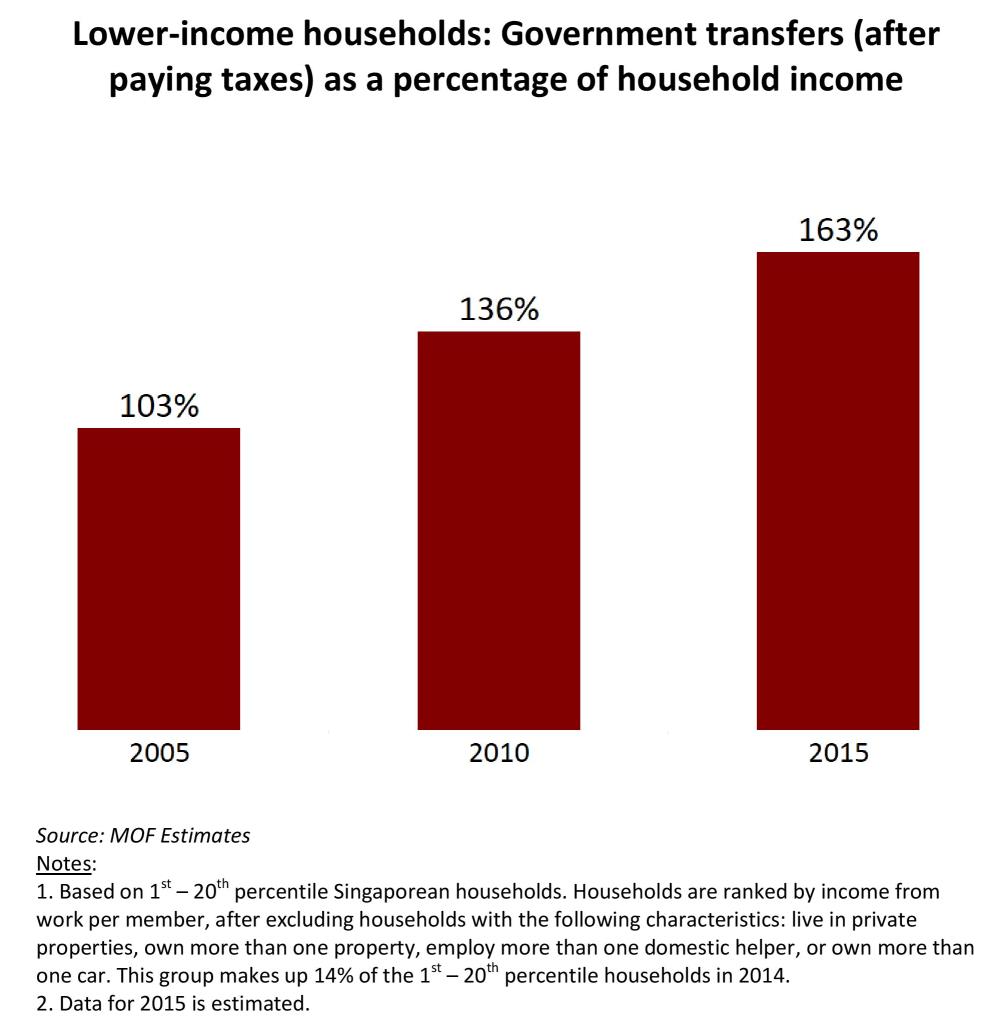
[Chart 8]
82. I recognise of course that there is some political cunning in saying that this all came about because of GE 2011. I’m sorry, it didn’t.
83. The world did not start in 2011.
84. We made clear our intentions and motivations, well before 2011, made clear that it was a multi-year strategy, and step by step, starting with the kids, through working life, and into the senior years, we have been moving towards a more inclusive society.
85. We intend to continue on this journey, learning from experience and improving where we can.
86. But this is a far more important agenda than a reaction to 2011.
KEEPING A CULTURE OF RESPONSIBILITY
87. We’ve got to do more to give everyone a fair deal in life, but do it in a way that gives everyone the pride of contributing in their own way.
88. No government can have a hands-off strategy, where people are left to fend for themselves. Neither should we have hand-outs all along the way, because that just takes the dignity out of people.
89. Let’s instead keep providing hand-ups, especially for those who start with less, helping them develop their strengths and have a real chance of doing well.
89. Empower people, and enable them to earn their own success.
90. We’ve also got to make sure too that this doesn’t end up the way it has in many other advanced societies, where it becomes a contract between me and the government – ‘I pay these taxes, I want this much back in benefits’. Civic society and civic participation is far weaker today in almost every advanced country compared to a few decades ago. Membership in civic organisations has declined.
91. We’ve got to keep a culture of responsibility across our society: individuals and families, government playing its part, but also a civic culture where we all feel involved and take the initiatives, as individuals, voluntary bodies and as businesses.
92. And we should never lose our Singapore culture, of thinking about our children and grandchildren. As the Chinese saying puts it: the ancestors plant the trees, the next generation enjoys the shade (前人种树,后人乘凉). But it’s not just for one generation.
93. We've got to keep planting trees for the next generation, and know too that each generation will enjoy the shade too as they grow old.
94. Let’s keep that culture in Singapore. Not making the short-term political calculation as to what’s best, but always looking out for the opportunities beyond today. That’s how we got to where we are, a society that has transformed itself for the better, for all its citizens, and that’s the way we go forward.
###
[1]
For more details on Singapore and international comparisons, refer to ‘
Ministry
of
Finance
Occasional
Paper:
Income
Growth,
Inequality
and
Mobility
Trends
in
Singapore
’.
(
![]() 1,149
KB)
1,149
KB)
[2] Figure includes all taxes, fees and charges.
Download the PDF version of this speech here:
-
For
reading
(
 2,025
KB)
2,025
KB)
-
For
printing
into
a
booklet
(
 2,809
KB)
2,809
KB)
